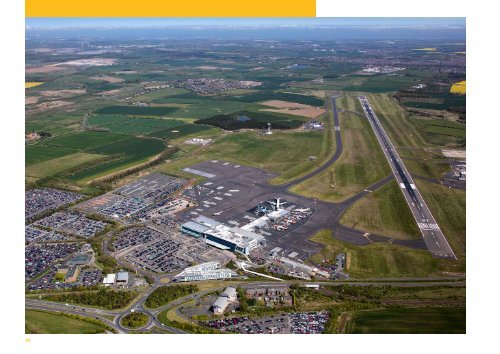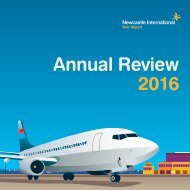Airport Masterplan 2035 LOW RES
You also want an ePaper? Increase the reach of your titles
YUMPU automatically turns print PDFs into web optimized ePapers that Google loves.
<strong>Masterplan</strong> <strong>2035</strong><br />
8. Development Plan<br />
8.1 To deliver the forecast growth of the <strong>Airport</strong> and secure the<br />
far reaching economic and social benefits this will offer,<br />
there will need to be investment in improvements to our<br />
operation. Additional infrastructure will likely be needed<br />
airside and landside to both stimulate and meet the needs<br />
of future demand.<br />
8.2 As the <strong>Masterplan</strong> is a long term strategy the specific<br />
development needs are reviewed at spaced out intervals,<br />
starting from the 2017 base year. Key diagrams in<br />
Appendix 1 illustrate what may have been developed by -<br />
l 2025<br />
l 2030<br />
l <strong>2035</strong><br />
The development needs for the following are set out –<br />
l Runway Length<br />
l Runway and Taxiway Capacity<br />
l Terminal and Apron<br />
l Airside Ancillary<br />
l Car Parking<br />
l Landside Ancillary<br />
l Freight and Employment Sites<br />
8.3 Assessment of our future requirements is largely based on<br />
a study undertaken by global consultancy Arup, working<br />
closely with staff from different specialisms at the <strong>Airport</strong>.<br />
Runway Length Performance<br />
8.4 The <strong>Airport</strong>’s current single runway is 2,329m (7,641ft) in<br />
length and 46m wide. Runway 25 20 (takes off towards the<br />
West) is used about 70% of the time, owing to the prevailing<br />
wind direction from the west, as aircraft need to take off<br />
into the wind to achieve greater lift. However, an area of<br />
high ground to the west of the <strong>Airport</strong>, known as Callerton<br />
Hill, needs to be cleared on take-off. Runway 25 also has a<br />
slight upslope.<br />
8.5 The presence of this high ground means that aircraft<br />
generally require more engine power to take-off safely than<br />
they ordinarily would on a runway of a similar length under<br />
the same atmospheric conditions. This uses more fuel at<br />
take-off which means that more has to be carried, adding<br />
weight to the aircraft. This issue presents the following<br />
challenges to our present and future operation –<br />
l Under some weather conditions and to certain current<br />
destinations, narrow body aircraft, because of the weight<br />
of the fuel needed and the amount used at take-off,<br />
either have to make a technical fuel stop on route, or<br />
operate with a reduced passenger load. This can have<br />
an adverse impact on the financial performance of<br />
affected flights.<br />
l Larger wide body aircraft serving long haul destinations<br />
can be restricted when using the <strong>Airport</strong>. Depending on<br />
the destination and aircraft type there may need to be a<br />
trade-off between the three contributors to aircraft takeoff<br />
weight: fuel, cargo, and passengers and baggage.<br />
The fuel needed to travel to a destination is largely set;<br />
therefore passenger numbers and/or cargo load may be<br />
reduced which could impact the viability of services to<br />
some destinations.<br />
l The need for added engine power to clear Callerton<br />
Hill also increases engine wear and the higher fuel<br />
burn on take-off adds cost to current and future airline<br />
operations.<br />
l The current runway’s stopping distance results in greater<br />
brake wear, especially for larger aircraft.<br />
8.6 We have already carried out ‘soft measures’ such as the<br />
reduction of vegetation at the western end of the runway<br />
to lessen static obstacles. However there is a limit to the<br />
impact such measures can have on the performance of<br />
aircraft using the runway.<br />
20<br />
Runway 25 is aircraft departing to the west and arriving from the east, with runway 07 being the opposite. The names relate to the degree of orientation.<br />
34<br />
35




